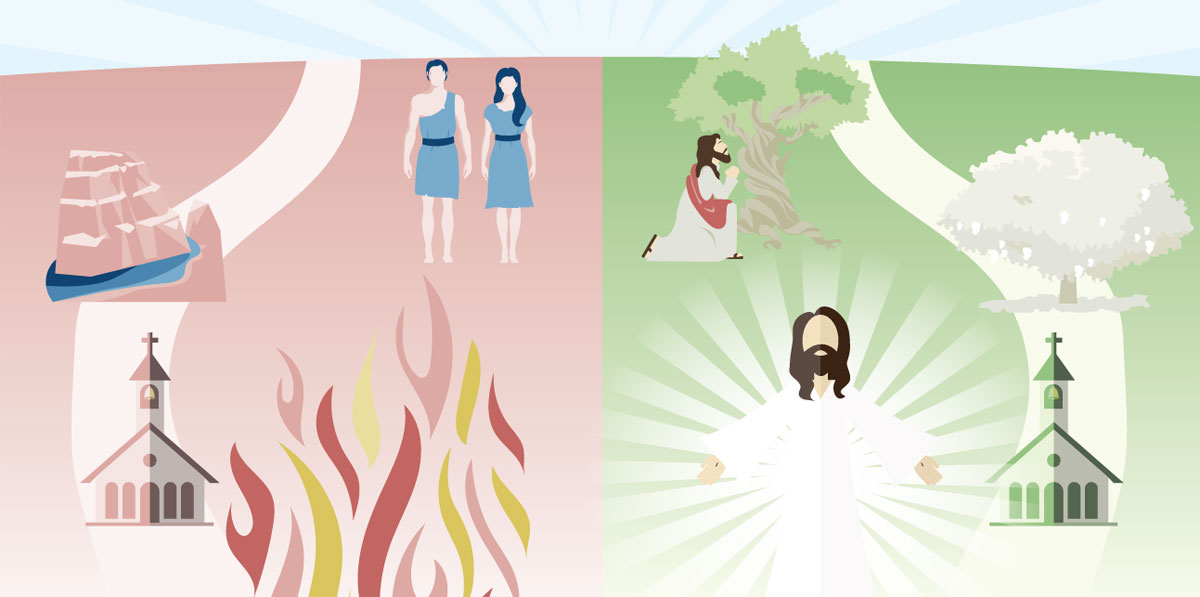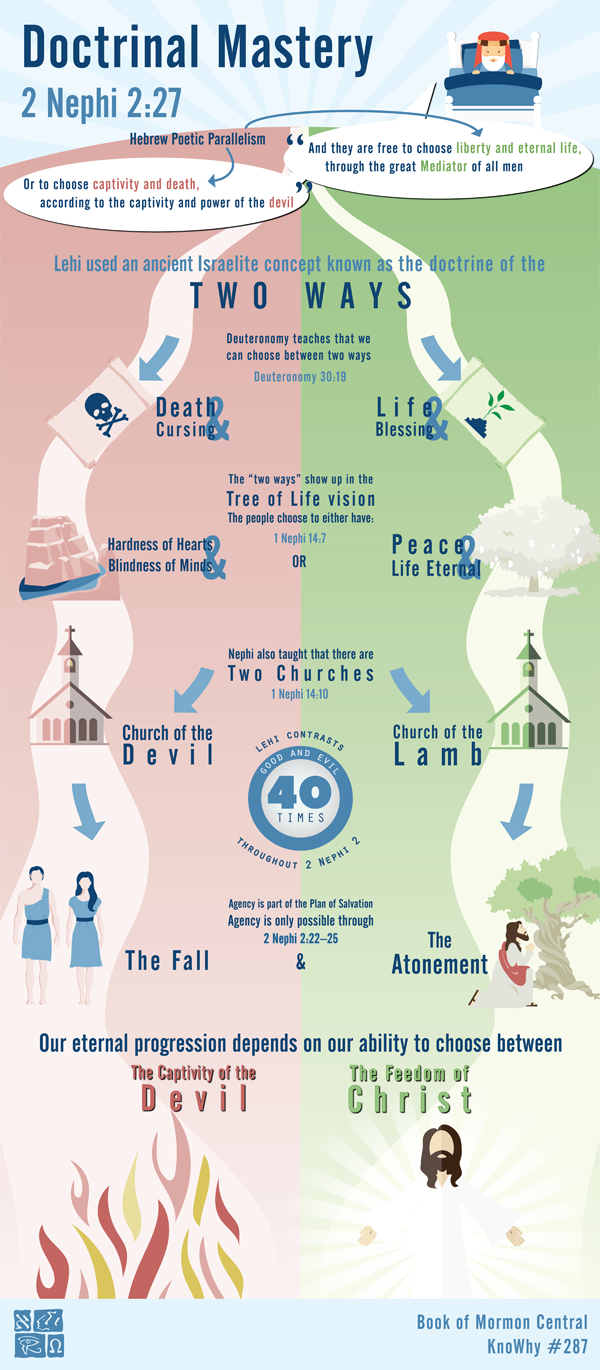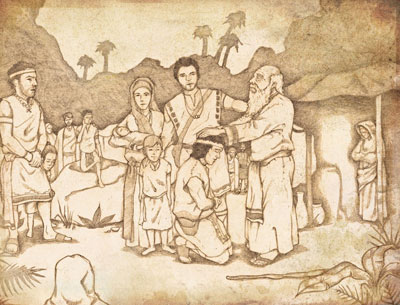
Context and Content
In 2 Nephi 2, Lehi left what he knew would be his last blessing upon his son Jacob. During this time, he spoke profoundly on the subject of mortality, as well as freedom of choice, or agency. He told his sons that they were “free to choose liberty and eternal life, through the great Mediator of all men, or to choose captivity and death, according to the captivity and power of the devil” (2 Nephi 2:27).1 In this verse, and throughout 2 Nephi 2, Lehi used an ancient Israelite concept known as the doctrine of the “two ways” to explain the principle of agency to his sons.2
This doctrine states that there are only two ways to live: the way of life, and the way of death.3 Lehi’s statement strongly echoes Deuteronomy, where Moses proclaimed, “I call heaven and earth to record this day against you, that I have set before you life and death, blessing and cursing: therefore choose life, that both thou and thy seed may live” (Deuteronomy 30:19). The doctrine of the two ways is also common in wisdom literature,4 a group of traditions which demonstrably influenced Lehi’s and Nephi’s writings.5
The “two ways” show up earlier in Lehi’s and Nephi’s visions. While an angel provided a guided tour through his father’s vision of the tree of life, Nephi was told that God would do a work that would cause people to go down one of two paths, “either to the convincing of them unto peace and life eternal, or unto the deliverance of them to the hardness of their hearts and the blindness of their minds unto their being brought down into captivity, and also into destruction” (1 Nephi 14:7).6 As part of the same vision, he saw that there were only two “churches,” representing the “two ways.”7
Doctrinal Mastery 2 Nephi 2:27 Infographic by Book of Mormon Central
In 2 Nephi 2 itself, Lehi brought up the stark contrast between good and evil more than 40 times.8 He even used the word “way” in connection with choosing between good and evil: “And the way is prepared from the fall of man ... And men are instructed sufficiently that they know good from evil” (2 Nephi 2:4–5). He then stated that there must be an “opposition in all things.” Otherwise, “righteousness could not be brought to pass, neither wickedness, neither holiness nor misery, neither good nor bad. Wherefore, all things must needs be a compound in one” and “remain as dead, having no life neither death, nor corruption nor incorruption, happiness nor misery” (v.11).
Lehi also made it clear that without the Fall, agency would be impossible, and hence, there would be no “two ways” that everyone must choose between (2 Nephi 2:22–25).9 Because of this Fall, and the Atonement that overcomes it, humanity is “free to choose liberty and eternal life, through the great Mediator of all men, or to choose captivity and death, according to the captivity and power of the devil” (2 Nephi 2:27).10 Lehi pled with his posterity to choose “the great Mediator ... and choose eternal life ... And not choose eternal death, according to the will of the flesh and the ... devil” (v. 28–29).
One can clearly see the poetic use of contrasting ideas in 2 Nephi 2:27. The balanced contrasting statements are a common feature of Hebrew literature, and they enhance the impact of Lehi’s teaching.
Contrasting Ideas in 2 Nephi 2:27
| And they are free to choose liberty and eternal life, | |
| through the great Mediator of all men, | |
| or to choose captivity and death, | |
| according to the captivity and power of the devil11 | |
Doctrines and Principles
Lehi’s teachings on agency demonstrate that moral agency—the ability all people have to choose between these two ways and act for themselves—is essential to Heavenly Father’s plan. Humanity’s eternal progression depends on which of the two ways people choose.12 All people have the ability to choose freedom through Christ and escape the captivity that the devil offers humankind.
Because of the Fall and the Atonement, mankind has the ability to choose the right way and follow Christ, rather than following any number of worldly ways, or alternative ways, which may instead lead down the “way of death.” As Neal A. Maxwell stated, “I testify that what a wise man wrote is true: ‘If you have not chosen the kingdom of God first, it will in the end make no difference what you have chosen instead.’ Having so chosen, may God bless us all to move the kingdom along.”13
Agency allows all people to choose right over wrong, helping them to slowly become better people with each right choice, and to repent from every wrong choice. Robert D. Hales declared “Agency allows us to be tested and tried to see whether or not we will endure to the end and return to our Heavenly Father with honor.”14 It is only through the Fall and Atonement that mankind has received the gift of agency, and those who use this gift wisely, and choose the right way, will have joy and be able to return to their Father in heaven.
Lehi famously said, “Adam fell that men might be, and men are that they might have joy” (2 Nephi 2:25). And how might men have joy? As Lehi’s next statement makes clear: by “choos[ing] liberty and eternal life through the great Mediator of all men,” and not “choos[ing] captivity and death, according to the captivity and power of the devil,” who seeks not our joy, but seeks to make us “miserable like unto himself” (2 Nephi 2:27).
Further Reading
President Thomas S. Monson, “Choices,” Ensign, May 2016, online lds.org.
Elder Robert D. Hales, “To Act for Ourselves: The Gift and Blessings of Agency,” Ensign, May 2006, online lds.org.
Elder Neal A. Maxwell, “Response to a Call,” Ensign, May 1974, online at lds.org.
- 1. The 1830 edition said "mediation" instead of "mediator", but this was a typographical error as the printer's manuscript clearly has "mediator." This error was corrected in the 1981 edition of the Book of Mormon. See Royal Skousen, ed., The Book of Mormon: The Earliest Text (New Haven, CT: Yale University Press, 2009), 753. See also Royal Skousen, ed., The Printer's Manuscript of the Book of Mormon, Part One: 1 Nephi 1–Alma 17, The Book of Mormon Critical Text Project, Volume 2 (Provo, UT: FARMS, 2001), 154; Royal Skousen and Robin Scott Jensen, eds., Revelations and Translations, Volume 3, Part 1: Printer's Manuscript of the Book of Mormon, 1 Nephi 1–Alma 35, The Joseph Smith Papers (Salt Lake City, UT: Church Historian's Press, 2015), 123.
- 2. For a discussion on the doctrine of the two ways in the Book of Mormon and the apocrypha, see Hugh Nibley, An Approach to the Book of Mormon, The Collected Works of Hugh Nibley, Volume 6 (Salt Lake City and Provo, UT: Deseret Book and FARMS, 1989), 204. Examples from the Old Testament are Jeremiah 21:8: “Thus saith the Lord; Behold, I set before you the way of life, and the way of death”; and Psalm 1:6: “For the Lord knoweth the way of the righteous: but the way of the ungodly shall perish.” For the “two ways” throughout the Book of Mormon, see Mack C. Stirling, “The Way of Life and the Way of Death in the Book of Mormon,” Journal of Book of Mormon Studies 6, no. 2 (1997): 152–204.
- 3. Brant A. Gardner, Second Witness: Analytical and Contextual Commentary on the Book of Mormon, 6 vols. (Salt Lake City, UT: Greg Kofford Books, 2007), 1:248.
- 4. See prominently, for example, Psalms 1:6. For an excellent summary of the two ways in wisdom literature, see Daniel P. Bricker, “The Doctrine of the ‘Two Ways’ in Proverbs,” Journal of the Evangelical Theological Society 38, no. 4 (1995): 501–517.
- 5. For two valuable treatments of Nephi and Lehi’s connection to wisdom literature, see Taylor Halverson, “Reading 1 Nephi with Wisdom,” Interpreter: A Journal of Mormon Scripture 22 (2016): 279–293; Alyson Skabelund Von Feldt, “‘His Secret Is with the Righteous’: Instructional Wisdom in the Book of Mormon,” FARMS Occasional Papers, no. 5 (2007): 49–83. See also Book of Mormon Central, “Why Did Nephi Work So Hard to Preserve the Wisdom He Had Received? (1 Nephi 6:5–6),” KnoWhy 262 (January 16, 2017).
- 6. John W. Welch, “Connections Between the Visions of Lehi and Nephi,” in Pressing Forward with the Book of Mormon, ed. John W. Welch and Melvin J. Throne (Provo, UT: FARMS, 1999), 51–52.
- 7. Book of Mormon Central, “Are There Really Only Two Churches? (1 Nephi 14:10),” KnoWhy 16 (January 21, 2016).
- 8. Alan Miner, Personal communication to Book of Mormon Staff, January 18, 2017. Miner has reformatted the chapter to highlight these contrasts, and a copy of Miner’s structuring is in possession of Book of Mormon Central Staff.
- 9. For more information on the fall in 2 Nephi, see Book of Mormon Central, “Why Did Lehi Teach that the Fall was Necessary? (2 Nephi 2:22–25),” KnoWhy 269 (February 1, 2017). See Royal Skousen, ed., Analysis of Textual Variants of the Book of Mormon, six volumes (Provo, FARMS, 2004–2009) 1:511.
- 10. Note the grammatical variants here. See Royal Skousen, Analysis of Textual Variants of the Book of Mormon: Part One, 1 Nephi 1–2 Nephi 10, The Book of Mormon Critical Text Project, Volume 4 (Provo: FARMS, 2004–2009) 511.
- 11. Adapted from Donald W. Parry, Poetic Parallelisms in the Book of Mormon: The Complete Text Reformatted (Provo, UT: Neal A. Maxwell Institute for Religious Scholarship, 2007), 63.
- 12. See Doctrinal Mastery: Core Document (Salt Lake City, UT: The Church of Jesus Christ of Latter-day Saints, 2016), 4, online at lds.org.
- 13. Elder Neal A. Maxwell, “Response to a Call,” Ensign, May 1974, online at lds.org.
- 14. Elder Robert D. Hales, “To Act for Ourselves: The Gift and Blessings of Agency,” Ensign, May 2006, online lds.org.
Continue reading at the original source →





